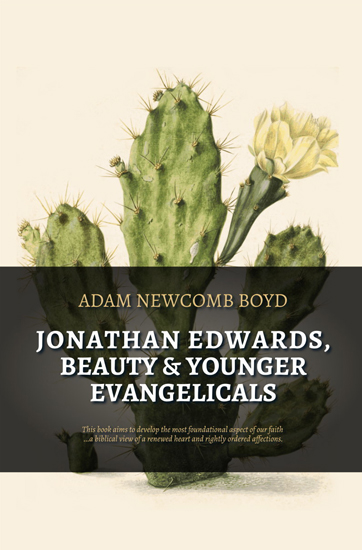Book Review – Adam Newcomb Boyd, Jonathan Edwards, Beauty, and Younger Evangelicals

Book Review
by Brandon Crawford
Adam Newcomb Boyd, Jonathan Edwards, Beauty, and Younger Evangelicals (JE Society Press, 2019). 236 pp. $18.99
The book begins with a word about the cultural shift currently underway in America—a shift that is being felt in evangelicalism as much as anywhere. As this shift takes place, many younger evangelicals are finding themselves caught on the horns of a dilemma (or so the author claims) as they find neither the doctrine-based Christianity of “older evangelicals” nor the intuition-based Christianity of the Emergents particularly satisfying.
This leads to the premise of the book: the author believes that Edwards can serve as a helpful guide to young evangelicals as they wade through the cultural morass. Edwards lived in a time of cultural upheaval as well, and he spent much of his intellectual energy thinking through its implications for the Christian faith. As the author finds Edwards’s conclusions satisfying, he believes they could be for young evangelicals as well. Thus, the book’s purpose is threefold: (1) “to explore the qualities of a healthy, biblical faith” with guidance from Edwards; (2) “to develop the most foundational dynamic of our faith”; which he identifies, with help from Edwards, as affection for the beauty of God; and (3) “to begin the healing process by looking at a biblical view of a renewed heart and rightly ordered affections” (p.7).
The book’s argument develops over the course of four chapters. Chapter 1 surveys prominent Bible figures including Jacob, Moses, David, Isaiah, Christ, Paul, Peter, and John. He concludes that “each of the characters and texts examined demonstrate the centrality of desiring the person of God, his beauty, his holiness, and his reality, above all other things…Simply put, there is no genuine Christian life apart from the affections.” (p.55)
Chapter 2 offers a summary of Edwards’s book, Religious Affections. The author shows Edwards’s continuity with the above mentioned biblical figures in rooting true religion in the affections. He identifies Edwards’s twelve marks of religious affection as: (1) The New Sense; (2) Lack of Self-Interest; (3) Love of [God’s] Moral Excellency; (4) The Enlightened Mind; (5) Effectual Conviction; (6) Evangelical Humility; (7) A Changed Nature; (8) A Spirit of Love and Meekness; (9) An Increasingly Softened Heart; (10) Symmetry of Virtues; (11) Increasing Desire; (12) Christian Practice. His conclusion is that genuine Christianity entails “more than a mere belief in the gospel; it is a sense of its beauty. It is exactly what the enlightenment stole from the church” (p.90).
Chapter 3 dwells on the cultural shifts which took place in Edwards’s day, including Edwards’s childhood and adult experiences as he lived through the changes. Boyd introduces us to Edwards’s father and grandfather and then to the philosophical and scientific developments of the 18th Century—in particular, the increasing hold of Enlightenment thinking upon society. Edwards’s response to these changes was not to completely discard the old or the new; rather, Boyd says, “Edwards held the best of both in an exceptionally orthodox way.” This is why younger evangelicals today must be introduced to Edwards, the author suggests (p.140). Edwards can show them how to navigate a cultural shift without losing the best of their orthodox heritage or dismissing out-of-hand every new cultural development . Edwards can teach them how to offer a biblical critique of the surrounding culture while also embracing its best elements, all the while keeping a doctrinally-rich and affectionate faith.
Chapter 4 is entitled, “A Model for Application.” Essentially, this chapter is a synopsis of a five-week teen Sunday School series that Boyd developed in order to teach the above concepts to young people. As such, this chapter reads very differently from the previous three. This chapter is written in a much more casual style than the previous chapters, and it abounds with pop culture illustrations.
The author provides a glossary defining the key terms used in his book, but curiously, he does not provide a definition of “beauty”—perhaps the most-used word in the book. He does define the words “affection,” aesthetics,” “Emergent Church,” “Postmodernism,” “Worldview,” and “Younger Evangelicals.”
The flow of the book’s argument can also be difficult to track at times as the author jumps from postmodern to early modern times, from Edwards’s midlife to his childhood, and from colonial America to the Emergent Church at a jarring rate. Some may also take issue with the author’s taxonomy of modern evangelicalism. For example, he places those who prioritize doctrine over matters of the heart under the label “older evangelicals.” But is this fair? Indeed, on occasion, the author seems to violate his own taxonomy as he cites John Piper and Timothy Keller as exemplars of Edwardsean piety, though their age would certainly place them in the category of “older evangelicals.”
A final curiosity was how the author justified his extensive use of pop culture illustrations in his teen class (such as showing TV commercials and movie clips) with the argument that Edwards did the same when he interacted with the latest in science and philosophy in his treatises (p.198). This would seem to be a clear category error and perhaps evidence of a superficial reading of Edwards and his times.
Each reader will have to decide for him or herself whether the author’s taxonomy of evangelicalism, use of illustrations, and flow of argument have merit. In this reader’s opinion, the greatest value of the book is not found in these, but in the observation that Edwards lived in a time of cultural transition like our own, and therefore could be a useful source of Christian wisdom as we navigate the present culture shift.